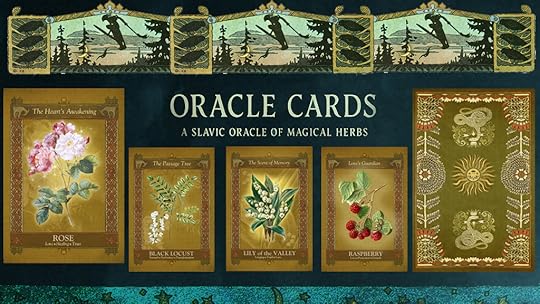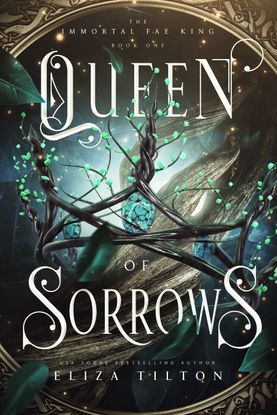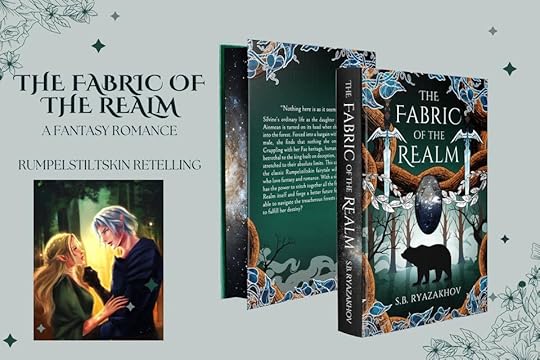Ronesa Aveela's Blog
October 31, 2025
Whispering Roots: Herbs of Second Sight
Some plants open the eyes, not the ones in your head, but the eyes that dream, that see beyond the veil. These are the herbs the old seers kept close, their roots hidden in shadowed gardens, their leaves steeped beneath moons few remember. Each carries a voice from the unseen world: one calls you to vision, another protects you from what would follow you home.
Below are six herbs of second sight: companions to the dreamers, the witches, and the walkers between worlds.
Sweet Flag(Acorus calamus)
They say the wind speaks clearer where sweet flag grows. Its long, swordlike leaves whisper along the edges of rivers and swamps, where earth and water touch, a place of reflection, of oracles. The Thracians burned its root before prophecy. The scent itself seems to cut through fog, both the mist upon the water and the mist of the mind.
It’s an herb for those who listen. A single thread of its smoke can sharpen the inner ear, helping one hear the truth beneath dream and omen. But it’s also a guardian: what walks out of the reeds isn’t always meant for mortal eyes. Sweet flag clears the path and keeps the traveler safe.
For: vision, clarity, sacred focus
Bearberry(Arctostaphylos uva-ursi)
Low and evergreen, bearberry clings to rocky slopes, unbothered by frost or wind. Its red berries shine like drops of heartfire amid the snow. Shamans once smoked its leaves before sleep, believing it would carry their spirits safely through the dark.
Bearberry belongs to the bear, the dreaming beast who sleeps through winter and wakes full of ancient memory. So too does this herb teach the dreamer endurance: to go deep into trance and still find the way back. It roots vision in the body, anchoring the soul after flights into the unseen.
For: grounding after vision, lucid dreams, spirit protection
Centaury(Centaurium erythraea)
A modest pink flower said to have sprung from the blood of Chiron, the wounded centaur, teacher of heroes. Centaury is for those who see too much, whose gifts exhaust them, whose hearts ache with what they cannot heal. The old herbalists brewed it as a tonic for “faint spirits,” believing it restored courage and discernment.
Psychically, it burns away illusions. Drink in its story and you’ll find yourself less easily deceived by spirits, by others, or by your own fears. Its magic is the light of reason within the realm of intuition, a lantern held steady in the hand of the healer.
For: discernment, inner strength, clearing false visions
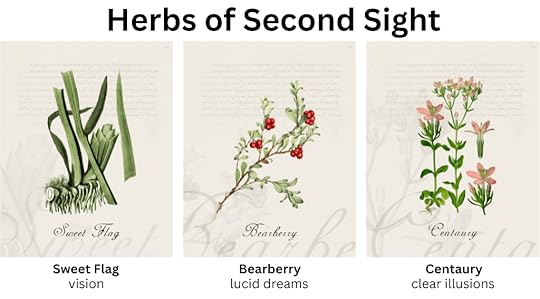
(Pimpinella anisum)
Sweet and aromatic, anise has long been a charm for vision and sleep. The ancients believed its seeds—tiny stars fallen to earth—could summon prophetic dreams and call friendly spirits to one’s bedside.
To this day, wise women scatter anise seeds beneath pillows or burn them upon coals before divination. The scent opens the crown of the head, a door through which moonlight enters. It’s a gentle herb, guiding rather than forcing revelation, turning the dreamer’s face toward truth like a flower to the sun.
For: dream magic, gentle clairvoyance, spiritual clarity
Valerian(Valeriana officinalis)
The root of valerian smells of earth, sleep, and the forgotten wild. It was once hung in doorways to keep away lightning and restless spirits, forces that disturb peace both inward and outward.
To open the inner eye, one must first still the outer senses, and that’s valerian’s gift. It quiets the mind’s clamor, allowing vision to rise softly from the silence beneath. Seers of the Middle Ages burned it in trance rites and dream vigils, trusting its smoke to guard them from the spirits drawn to psychic light.
For: meditation, trance, protection from psychic disturbance
False Hellebore(Veratrum lobelianum)
This isn’t an herb to touch lightly. False hellebore grows where the earth’s magic runs deep and dangerous: near bogs, old graves, and places where lightning once split the ground. In ancient divinations, its roots were brewed by those who sought visions through ordeal. Many never returned.
Yet in folklore it was also a guardian: planted on thresholds to ward off envy and the evil eye or used symbolically in rites to represent the peril of knowledge. Its lesson is the same now as it was then: power untempered by wisdom destroys.
False hellebore stands at the edge of the vision path, whispering: Do you truly wish to see?
For: shadow work, protection rituals, symbolic use only

The old ones taught that second sight isn’t granted; it’s grown. These herbs don’t force the way open; they walk beside you, teaching patience, teaching reverence. Sweet flag calls the spirits, bearberry brings you safely home, centaury keeps your heart steady, anise opens the dream gate, valerian guards the threshold, and false hellebore warns what lies beyond it.
Use them wisely, with the respect due to all things that speak in whispers. For the deeper you look, the more the world begins to look back.
The Slavic OracleCheck out our Oracle Deck Kickstarter campaign to discover more about using herbs in divination: https://www.kickstarter.com/projects/ronesa-aveela/slavic-divination?ref=3dp9ve
October 24, 2025
St. Demetrius and the Cooling of the Dragons
October 26 – Dimitrovden
As the fields grow quiet and the air turns sharp with the promise of frost, Bulgarians celebrate Dimitrovden, the Day of St. Demetrius, on October 26. It marks the turning of the year, the time when summer’s fire fades and winter’s breath arrives. In ancient calendars, this day signaled the beginning of winter, just as St. George’s Day (Gergiovden) marked the beginning of summer. The two saints, often seen as twin brothers, balance the cycle of warmth and cold, life and death.
[image error]

Deisus with St. George and Demetrius, public domain via Wikimedia Commons
The Twin Horsemen of the Seasons
Legends tell that George rides a white horse, youthful and full of vitality, while Demetrius, on his red steed, is old and snow-bearded. He shakes white flakes from his hair or pours snow from a sack, blanketing the earth in stillness. If St. George awakens the fields and protects them from dragons that bring drought, St. Demetrius puts those dragons to sleep, cooling their fiery breath.
In Bulgarian tradition, dragons aren’t always monstrous; they’re often forces of untamed passion, storm, or greed. Some legends tell of St. Demetrius descending from the mountains to rein in these wayward spirits, sealing their caves with frost and silencing their thunder. In this sense, Demetrius is not only a dragon-slayer but a dragon-tamer, restoring balance when the heat of summer threatens to consume the world.
Deisus with St. George and Demetrius, public domain via Wikimedia Commons
Herbs That Repel Dragons
As the season turns and the dragons grow restless, villagers once turned to herbs for protection, plants that cool the air and heart, driving away both fever and fury.
Sweet Clover (Komuniga) and Gentian (Tintyava) were believed to cool unwanted dragon passion, the wild, consuming heat that could stir storms or inflame tempers. A bundle of these herbs, hung in the home or stable, helped keep such forces in check.Tansy, golden and resilient, guarded the heart. Just as it strengthens the body, it was thought to shield one’s inner flame from being extinguished by cold or inflamed by wrath.Wormwood, sharp and bitter, was the most powerful of all. Burned in small amounts, it was said to banish dragons and evil spirits, purifying the home and clearing the air of envy and misfortune.
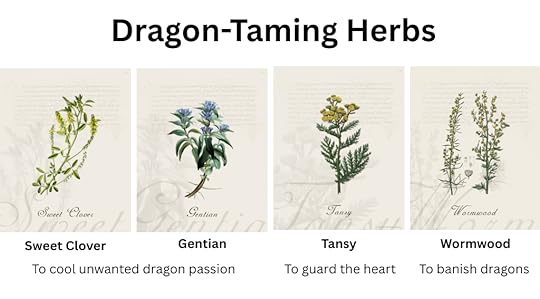
These herbs were often gathered during the height of summer, when their power was strongest, and preserved for use in late autumn—when the saints’ feast days marked the battle between fire and frost.
From Dragon-Slaying to Soul-Keeping
While St. George slays the dragon to release spring’s life force, St. Demetrius ushers souls and spirits to the underworld, where they rest beneath the frozen earth. The Saturday before his day, called Dimitrovska Zadushnitsa, is one of Bulgaria’s traditional All Souls’ Days—a time to honor ancestors and light candles for the departed.
Like the Thracian Horseman, an ancient figure who rode between worlds, Demetrius represents the threshold between life and death, summer and winter, passion and stillness. His spear may pierce not only the body of the dragon but the restless heart of chaos itself, restoring cosmic order.
A Ritual for Dimitrovden
To honor St. Demetrius and the turning of the season:
Light a small candle or oil lamp to symbolize the fire that endures through the dark months.Place sprigs of komuniga, tintyava, tansy, or wormwood near your doorway or window.Offer a quiet prayer for balance: the courage of St. George, the wisdom of St. Demetrius, and the calm heart that can hold both fire and frost.As the snow begins to fall, remember that not all dragons must be slain. Some only need to be cooled, their flames tempered by patience, rest, and the turning of the year.
Explore the Herbs of the Dragon-Slaying Season
In The Slavic Soul oracle deck campaign, each plant reveals its ancient wisdom and protective power. The herbs of Dimitrovden—komuniga, tintyava, tansy, and wormwood—speak of balance, protection, and the cooling of the spirit.
Let them remind you, as St. Demetrius rides across the frozen fields, that every ending carries the seed of renewal.
All backers can get free copies of some of our herb prints added to their rewards when the campaign ends. Simply comment on our weekly question posts.
Until 9 pm Eastern Time Sunday, October 26, we’re running a flash sale. All backers can add on 5 digital herbs for $5. Any herbs from our selection of 78.

Take a look at our campaign here: https://www.kickstarter.com/projects/ronesa-aveela/slavic-divination?ref=3dp9ve
October 17, 2025
October Magic: Herbs, Witches, and the Secrets of the Slavic Soul
October is a month woven with mystery. The air turns crisp, the veils between worlds grow thin, and magic dances in every shadow. From the first golden leaves to the night of Halloween, this is the season when the unseen becomes visible, a time when witches, dragons, and forest spirits step quietly into our world once more.
Although many see magic today as a playful party theme, in Slavic lands it’s always been part of life itself, a sacred knowledge passed down through stories, herbs, and rituals.
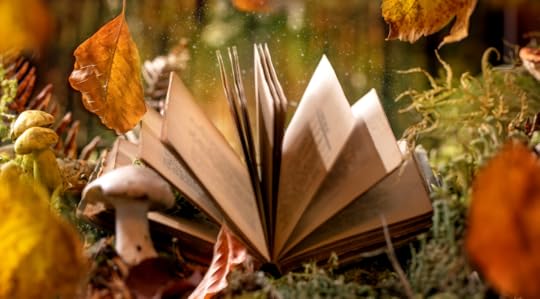
The Magic of Love
In Bulgarian folklore, love itself is an enchantment, and herbs are its gentle allies. Our grandmothers knew that a sprig of basil could keep a lover faithful, that ivy promised a bride happiness, and that mistletoe — sacred even in winter — could bring true love before the year’s end.
A pinch of ginger was burned to strengthen passion. A cup of lemon balm tea calmed hearts after quarrels. Dill washed away jealousy, while valerian, beloved of the forest nymphs, reminded mortals that love must be handled with care.
And when longing turned to loneliness, charms existed to call a soulmate in dreams:
“St. Luke, St. Luke, be kind to me,
In dreams let me my true love see.”
These simple rituals weren’t only spells; they were acts of hope, reminders that love is as natural and mysterious as the plants growing by our doors.
Herbs of ProtectionBut in the old tales, not every magic was sweet.
In Slavic mythology, fiery dragons (zmey) and restless spirits tested humankind’s courage. To guard their homes, villagers burned St. John’s wort, wormwood, or wild savory, letting their smoke cleanse both air and soul.
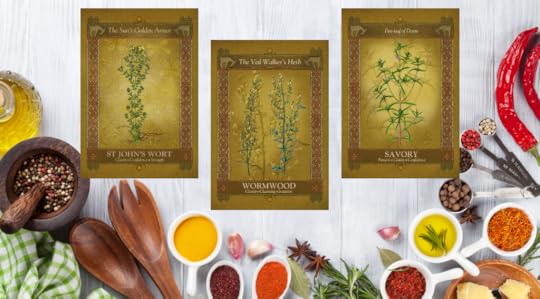
Girls wore melilot to protect themselves from unwanted dragon passion or to break it, if already caught in its spell.
These herbs taught an important truth: the same earth that grows tenderness also offers protection. Magic, like life, requires balance.
Witches, Wizards, and “People with Knowledge”This season also honors those who carried that balance, the witches, healers, and “people with knowledge.”
In Slavic folklore, both women and men practiced magic. The word ved’ma (female witch) and vedun or ved’miak (male witch) come from vedat’ — “to know.” To be a witch was to be one who knows.
These wise folk understood the four elements — fire, air, earth, and water — and used herbs to make or break spells of love, health, and fortune. Their power wasn’t tied to the Devil, as later Western tales claimed, but to nature itself.
Legends even say that those born as sorcerers bore a hidden mark, a small tail, and guarded a secret black book filled with recipes for charms and potions. Whether truth or fable, these stories remind us that knowledge, especially of the natural world, was once considered the greatest magic of all.
And if you hear a whisper in the sky on Halloween night, perhaps it’s Baba Yaga herself, the most powerful Slavic witch, flying in her mortar to visit friends or to stir a cauldron of laughter and mischief.

Baba Yaga book: https://ronesaaveela.com/ronesa-aveelas-books/spirits-creatures-a-study-of-series/a-study-of-baba-yaga/
From Folklore to OracleEvery herb, every spell, every whisper from these tales has inspired our Oracle of the Slavic Soul — live now on Kickstarter.
Each card in the deck reflects an ancient symbol of love, protection, or wisdom, brought to life through original art and stories.
As you brew your tea, carve your pumpkins, or dance under the October moon, remember: magic isn’t just in the past. It lives wherever there is curiosity, courage, and love.
Join us in the Circle of Magic and back the campaign today: https://www.kickstarter.com/projects/ronesa-aveela/slavic-divination?ref=3dp9ve
Why This Deck Is DifferentThis isn’t a mass-produced deck. Every single card, from the design to the art to the messages, was created by me. No teams, no factories — just passion, intention, and spiritual guidance are its foundations.
Inspired by ancestral wisdom, the mystical legacy of Bulgaria’s own Baba Vanga, and the healing energy of my grandmother, this deck is deeply personal and energetically alive. The deck’s wisdom comes from my book 77½ Magical Healing Herbs.
It’s my heart in card form, and I can’t wait to share it with you.
Rooted in HeritageI was raised in Bulgaria, where mysticism is woven into everyday life. Stories of Baba Vanga, the blind prophet, were told like legends but also like truth. Her presence, and the quiet power of my grandmother, instilled in me a deep respect for intuitive wisdom. This Oracle deck carries their essence.
More than a DeckThe campaign offers more than an oracle deck. We have an art book of the herbs uses (the same herbs as in our book 77½ Magical Healing Herbs). Plus posters and individual art prints.
Special FLASH REWARDBe sure to check out the campaign beginning Saturday, October 18, at 9 a.m. Eastern Time. We’ll be offering a WEEKEND SALE until Tuesday at 9 p.m., where you can ADD a second oracle deck for $20 off the regular price.
Select a tier that has an oracle deck.During the check-out process, look for the ADD-ON that says “FLASH REWARD – ORACLE DECK WEEKEND SALE” and select it. You can add up to 10 additional decks.This flash reward expires on Tuesday, October 21, at 9 p.m. Eastern Time.Here’s the campaign link again: https://www.kickstarter.com/projects/ronesa-aveela/slavic-divination?ref=3dp9ve
***
And now for another special treat…of the culinary kind.

(A Bulgarian Autumn Delight)
Legend says that every pumpkin hides a little sunshine — and this cake captures it all.
Ingredients of Warmth & Magic
3 golden eggs1 cup sugar (for sweetness and joy)1 cup grated sweet pumpkin1 cup chopped walnuts1 pinch of cinnamon (add as much as your heart desires)2 teaspoons vanilla1 cup flour1 packet baking powderHow to Make It
Beat the eggs with sugar until light and frothy. This is where the magic begins.Add pumpkin, cinnamon, and vanilla.Stir in the flour mixed with baking powder.Finally, fold in the walnuts . Their oils will make the cake tender and rich.Pour into a greased, floured baking pan and bake at 180°C / 350°F until golden.Finishing Touch
Sprinkle with powdered sugar like the first snow of autumn
Let it cool. Patience keeps the sweetness intact.
Serve with tea, love, and a story from your grandmother’s kitchen.
October 10, 2025
From Harvest to Healing: The Folklore of Autumn Herbs
As the golden light of autumn ripens and the air turns crisp, nature invites us to pause and gather what has grown — not only from the earth, but from within ourselves. Across the Slavic lands, this season is known as a time of harvest and preparation, when herbs are dried for winter and rituals honor the healing power of the land.
In Bulgarian folklore, October culminates with St. Dimitar’s Day (Dimitrovden, October 26), marking the turning of the year from summer’s warmth to the long rest of winter. People used to say, “St. George brings summer, St. Dimitar brings snow.” It’s a time to bring the animals indoors, share stories by the hearth, and finish gathering the last roots and berries that hold the earth’s final pulse of power before it sleeps.
In creating The Slavic Soul oracle deck, we drew inspiration from these ancient traditions, where every leaf carried meaning, and every scent whispered a story. Each card in the deck embodies not only plant magic but also the soul’s wisdom.
Here are a few autumn guardians that inspired our journey:
Pot Marigold (Calendula officinalis)The plant’s genus comes from the Latin calendae for “the first day of the month,” because the flower was believed to bloom on this day each month.
The brighter the flower color, the greater healing substances the plant produces. Marigold has antibacterial, anti-inflammatory, and astringent effects, making some people call it a pharmacy in one plant.
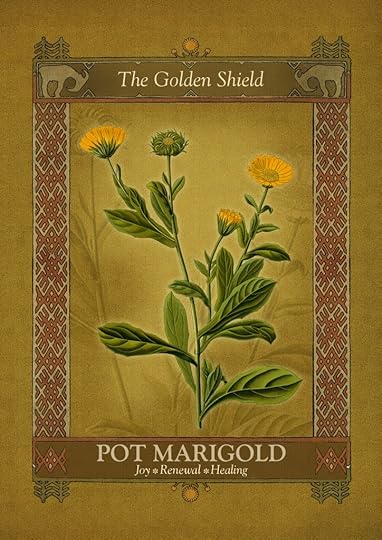
In Bulgarian folklore, the plant was considered one of the most healing herbs. It was a protection against spells and the “evil eye” (uroki). Having a bouquet of the flowers in your home protects you and your family from harm and gives everyone more energy. The plant also protects people from bad thoughts and can give them prophetic dreams.
Brides and grooms wore it to ensure dragons and Samodivi didn’t harm them. In addition, at Slavic weddings, newlyweds once danced barefoot on the ground. Afterward, their fathers dug up some of that soil, put it into a pot, and planted marigold, because it was believed to bring joy, affection, love, and longevity to the couple.

The word “rose” comes from the Greek rodon for “red,” the color of the flower grown in ancient civilizations. The flower is the symbol of divinity.
Bulgaria is the biggest producer of rose oil in the world, accounting for approximately 70-75% of global production, particularly from the Rosa damascena variety grown in the Valley of Roses. This region offers ideal growing conditions, allowing Bulgaria to maintain its long-standing reputation for high-quality rose oil, which is prized in the fragrance and luxury skincare industries for its refined aroma
Herbalist Emil Elmazov says women should consume jam made from roses to keep their skin soft. This advice comes from a century-old tradition in which certain city ladies met every Friday and ate rose jam together. Over time, they noticed their skin became more radiant. Today, research shows that roses have a healing effect on the skin.
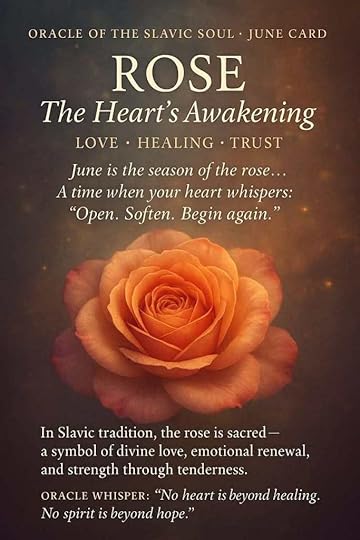
Roses are so important to Bulgaria’s history and culture that every year, on the first Sunday in June, people hold a Festival of Roses. The air is filled with fragrance, and the streets with traditional songs and dances.
Roses have long been the symbol of love, and rose oil, too, helps you achieve that. A ritual to awaken tender feelings from even the hardest heart involves rubbing essential oils from roses, rosemary, basil, and ginger into the middle of your forehead. Rose oil also restores trust and heals emotional grief, whether it’s from bereavement or a heart hardened from abuse, despair, or rejection.

The genus name comes from a Greek word meaning “courage,” as the plant was considered a source of courage. For this reason, women gave war-bound men gifts that included thyme leaves. The specific name comes from a Greek word meaning “to creep.”
Thyme has been used in official and traditional medicine for a long time (centuries for traditional medicine). Wild thyme seems to be less effective than common thyme, however. The most popular folk remedy is as an infusion or syrup for respiratory problems, such as bronchitis, whooping cough, and sore throats.
In Slavic culture, thyme is called “mother’s soul.” A famous Czech folk belief is that upon dying, a mother’s soul is changed into this fragrant flower. Wherever the plant grows wild, it’s believed it purifies its surroundings and enlivens spirits with its fragrance. From thyme, Slavs make a ritual bread called bogovitsa, “god bread.”
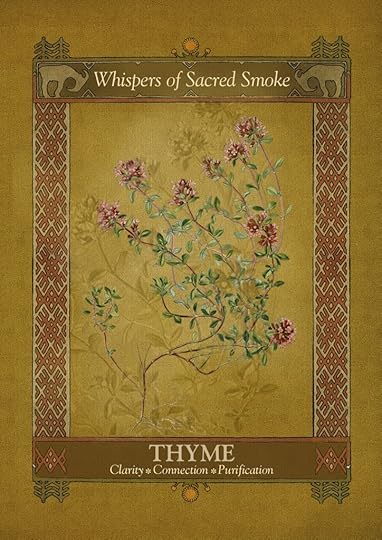
I remember my grandmother in those days — her hands stained green from herbs, her kitchen filled with the scent of thyme, savory, and dried peppers. She gathered thyme to make Sharena sol, the colorful salt that flavored not only our meals but our memories. A pinch of it carried warmth through the long winter and a blessing for health, love, and home.
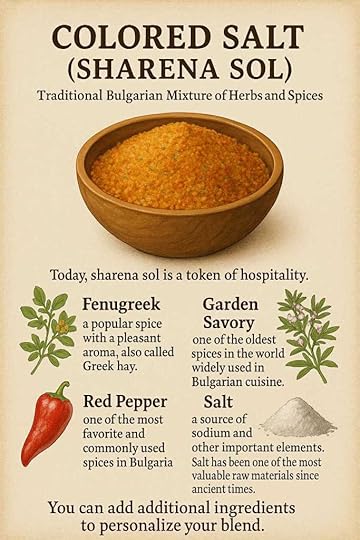
The Slavic Soul oracle Kickstarter campaign goes live on Tuesday. October 14, at 9 a.m., Eastern time. It’s a celebration of nature, art, and ancestral wisdom brought to life through 78 magical cards. Along with the cards, we have a beautifully illustrated expanded guidebook, an art book, and lots of digital add-ons.
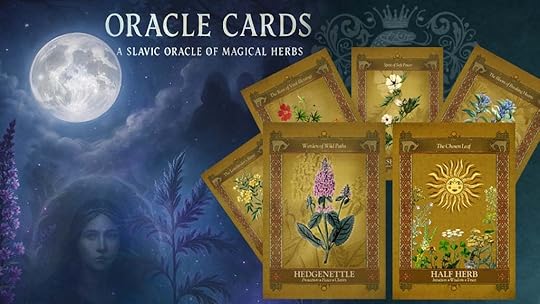
Join us to be part of this journey where ancient folklore meets modern intuition.
Follow the project here: https://www.kickstarter.com/projects/ronesa-aveela/slavic-divination?ref=3dp9ve
This witchy season, may your home be filled with the aroma of herbs, may your heart be full of gratitude, and may your spirit be guided by the quiet magic of the earth.
ARC OpportunitiesFrom time to time, I have get word about advance review copies from authors I know. Here are a couple I think you might enjoy.
“I lie best when I believe it myself, and even better when the truth could get me killed.”
For fans of The Hunger Games, Red Rising, Ender’s Game, and Scythe.
Sixteen-year-old Wren thought she was saving lives. But when her resistance mission goes wrong, she’s sentenced to death by the Equilibrium. Her only choice? Become a pilot in their Shadow Squadron—a brutal program that turns teens into perfect weapons.
Each mission keeps her alive… but erases more of who she is.
Finalist, Faulkner-Wisdom Competition.
Download your free ARC today, enter the cockpit, lose yourself.
https://booksprout.co/reviewer/review-copy/view/236754/the-conduit-trials
Surrendering to the immortal fae king was never her choice. Falling for him will be her greatest betrayal.
Deirdre’s fate was sealed before birth: one day, she would become the bride of the Deathless One—a title that promised more chains than vows.
Desperate to escape that future, she risked everything to flee with the man she loved. But when her defiance ends in blood, the immortal fae king drags her to his isolated realm, not as a queen, but as a captive.
With the vicious creatures and ancient magic of Kane’s kingdom bending to his will alone, Deirdre’s only hope as a mere mortal lies in wielding deceit like a weapon to cut down his defenses. Yet each clash with the fae king sends her resolve wavering between hatred of her immortal captor, curiosity about his secrets, and a genuine allure as inescapable as her situation.
The closer she gets to uncovering a weakness to destroy him, the more she’s ensnared by his shadowy charms. To escape, she must find the weakness that could destroy his soul, but with every whispered promise and stolen moment, Deirdre’s resolve wavers.
The Deathless One is not what she thought, and with war brewing on the kingdom’s borders, neither can afford her hesitation. But honoring her original plan will shatter both their fates…and following her heart will destroy the very world she vowed to save.
Uprooted meets The Cruel Prince in this lush, dual-POV fantasy romance that’s perfect for readers who love epic worlds, enemies-to-lovers, slow burn romance, and meddling pixies.
https://booksprout.co/reviewer/review-copy/view/228793/queen-of-sorrows
July 25, 2025
Whispers of the Forest: How Samodivi Shield the Earth
In the heart of Bulgarian folklore, deep within the shadowy forests, there lives a legend as beautiful as it’s haunting: the Samodivi.
Also known as Samovili in some regions, these supernatural women are nature spirits—wild, unearthly, and fiercely free. They appear most often on moonlit nights, dancing in glades or near springs, their hair unbound and glowing, their eyes full of secrets. They wear white robes or gowns spun from mist and starlight, and they are often barefoot, though their footsteps leave behind healing herbs—or death.

Samodivi aren’t quite fairies, not quite witches, and certainly not human. In many tales, they’re the guardians of sacred places: ancient trees, mountain springs, or meadows that bloom out of season. If disturbed, they may bless or curse, heal or haunt.
Nature’s Protectors but also Its WrathTo glimpse a Samodiva is to risk everything.
If a man spies on their dances, he may be struck blind or fall madly in love, wasting away unless she takes pity on him. If someone steals a piece of her clothing—especially her veil or sash—he can control her. But once she regains the garment, she’ll vanish forever, sometimes taking cruel revenge.
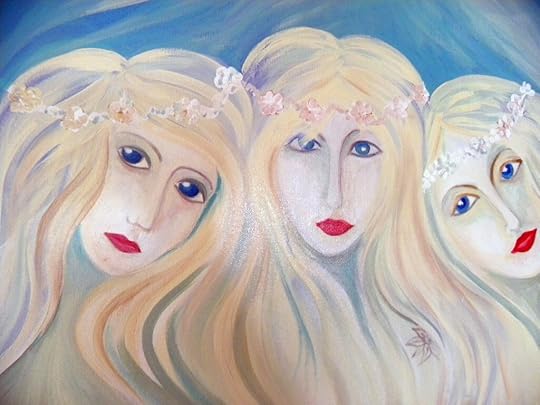
Yet Samodivi are not evil. Many stories show them punishing those who damage the land or act with greed. In a sense, they’re wild justice. The feminine face of the untamed world. In fact, the “diva” part of their name means “wild.”
Echoes of Ancient GoddessesSome folklorists believe Samodivi are remnants of older Slavic or Thracian deities—perhaps forest goddesses or priestesses or daughters of Bendis, the Thracian moon goddess. Their rituals, their dances, their connection to the moon and nature suggest pre-Christian roots that still linger beneath the stories.

In modern fiction and poetry, they’re often reimagined as tragic figures caught between realms, as witches wrongly accused, or as eternal spirits trying to reclaim what was lost when the forests began to die.
Why I Write About ThemIn our urban fantasy series, The Cursed Ring, the Samodivi aren’t just myth, they’re part of the living world. They hold knowledge the rest of us have forgotten. But their world is changing. Forests are dying. Ancient bonds are breaking. Kalyna and her agency, Wildlife Guardians, has a mission to protect nature from being destroyed.
Soulmate and Sacrifice BookOur Kickstarter campaign is coming to a close.
Sunday, July 27, a special day for Nelly, will be the last day you can get an early copy of the book through the campaign. When we go to production, the ebook will be available only through Amazon’s Kindle Select program (Kindle Unlimited).
Also, did you know when you download digital books from retailers, did you know you don’t OWN them?
When you buy a digital book, you’re actually buying a license to read it—not full ownership like a physical copy. That means the retail site can, in some cases, remove it from your library, and you can’t resell or share it like a paper book. If you’d like to own a copy, forever to be yours, the best option is to buy directly from authors.

To stop an ancient, murderous cult intent on destroying the world, I must either betray my duty or sacrifice the one I love.
Life as a paranormal crime investigator can be a bitch. Especially when evidence points to my soulmate as the prime suspect in a gruesome ritualistic killing.
And I believe Stefan’s guilty. He holds a damned ring that I cursed three millennia ago—one that has already claimed too many lives. If I can’t get him to remember our timeless bond, I’ll lose my soulmate forever.
Even worse, if the cult completes its twisted agenda, they won’t just murder Stefan—they’ll unleash a global catastrophe.
Racing against forces both mortal and ancient, I must unravel dark secrets I helped create. But if I uphold justice, I’ll lose the man I’ve spent a lifetime searching for—and my divided loyalties will doom us all.
Campaign link: https://www.kickstarter.com/projects/ronesa-aveela/cursed-ring-series?ref=5qqb1l
July 15, 2025
From Slavic Magic to Summer Liberation: The Burden-Busting Jar
This July, as fireworks light the skies and we celebrate freedom around the world, I invite you to celebrate a different kind of independence—the freedom from old burdens, heavy thoughts, or even stubborn financial worries.
Inspired by a quirky and magical Slavic practice known as Simoron, this ritual transforms stress into lightness using just a few kitchen staples… and a lot of imagination.
What Is Simoron?
Born in Russia and Ukraine, Simoron is a joyful, humorous system of playful rituals that grew out of Slavic cultural roots. Unlike traditional magic, Simoron doesn’t take itself too seriously—yet it’s deeply effective. Think of it as folk magic meets theater meets positive psychology. Its creators, Peter and Petra Burlan, believed that absurdity unlocks the subconscious and opens the door to miracles.
One of Simoron’s core principles?
Laughter is a spell. The more joyful and ridiculous the ritual, the more powerful the shift.

In this ritual, we use a fizzy reaction—yes, like a mini volcano!—to symbolically release what’s been weighing us down.
Here’s how to do it:
Write your burden.On a small slip of paper, jot down something you’d like to release. A debt, a bad habit, a limiting fear. Keep it short and symbolic (e.g., “overwhelm,” “credit card,” “self-doubt”).Create your “magic jar.”
Place the paper in a small glass jar or cup. Sprinkle a spoonful of baking soda over it. Now comes the fun. Pour in a little vinegar or lemon juice and watch the fizz!This reaction represents the energy of your burden dissolving, bubbling away into nothing.Speak your freedom.
As it fizzes, declare aloud something empowering like: “I’m free from this burden. Watch it fizz into freedom!”Let it go.
Once the fizz settles, pour the liquid down the drain, symbolically washing away the old. You can bury or toss the paper, then wave a little flag of freedom (draw one, make one, or just wave your hand like a wand) or release a paper butterfly as a gesture of liberation.
Why It Works
Simoron rituals like this one are deceptively simple. They trick the logical mind into stepping aside, letting creativity and play rewire how we feel. Just like ancient Slavic village spells used symbols like bread, bells, or water, modern rituals use vinegar and baking soda to burst the problem with a laugh. And somehow? It works.
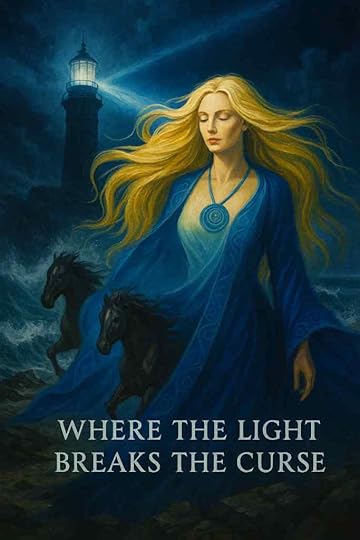
This ritual also echoes a key moment in my urban fantasy series, The Cursed Ring, where the heroine Kalyna must release the pain of her past to claim her true power and her love. In Slavic lore, freedom is rarely granted. It is won through courage, cleverness, and letting go of fear. The same truth lives inside us now.
The campaign is live now: https://www.kickstarter.com/projects/ronesa-aveela/cursed-ring-series?ref=5qqb1l
We’d love your support to get these beautiful covers done and be able to complete the magic of the series. Kickstarter isn’t a donation program. It’s a place to help people create projects. Think of yourself as an investor in a project before it’s completed.
In the world of The Cursed Ring, ancient spirits like Yudi, Zmey, and the Samodivi test those who carry burdens. And only when the heart is light—like a butterfly—can the soul break free from the curse.
Your Invitation
If you loved this ritual, stay tuned. I’m working on a 12-month collection of rituals. We’ll also be running a Kickstarter for Oracle cards later this year. We hope they bring joy, healing, and a bit of Slavic sparkle into your home.
Would you like more of these rituals? Or a collector’s set?
Reply to this email. I’d love your input as I prepare for a “Make 100” Kickstarter launch early next year.
Until next time, may your July be fizzy, free, and full of light. This is my favorite month because the Universe and God created me.
From my soul to yours,
~ Ronesa Aveela
Folklore dreamer and author of The Cursed Ring series
July 11, 2025
The Soul’s Steed: Horses in Thracian Belief
A glimpse into the soul-guides of Thracian myth—and Kalyna’s ghost mare
In ancient Thracian belief, horses were more than beasts of burden. They held a sacred role, not only in life but also in death. More than companions or symbols of status, they were seen as psychopomps—guides who carried the souls of the dead across the veil on their final journey to the Otherworld.
On the Summer Solstice, when the boundary between realms thinned, people believed horses could cross that burning threshold, bearing messages between the living and the dead. Warriors were buried with their steeds, not out of pride, but because no soul should ride alone into the next life.

White horses, in particular, were revered as liminal creatures able to move between realms. In funeral rites, they were sometimes sacrificed or depicted as spirit animals who carried the dead across rivers or thresholds separating the living world from the land of the dead. This motif appears in burial mounds across Thrace, where horse and rider are entombed together, suggesting a belief that the bond between them endured beyond death.
These traditions reveal a deep reverence for the horse as a bridge between worlds—a creature trusted with the most delicate cargo of all: the human soul.
***
If you missed our blog post on the Thracian Gate to the Beyond, now’s the perfect time to read it: Discover the Myth Here
Hope Rides Between Worlds
The Cursed Ring series isn’t just a fantasy story. It’s a journey through forgotten Thracian rituals, cursed artifacts, and creatures that slip between day and night.
One such soul-guide is Kalyna’s horse called Hope—a white mare as luminous and untamed as a dream, with eyes that remember too much. She slips between day and night, appears where she shouldn’t, and sees what others can’t. But the mare doesn’t belong to Kalyna. Hope belongs to someone else. Someone lost to fate. The one whose return might tear the veil between worlds apart.
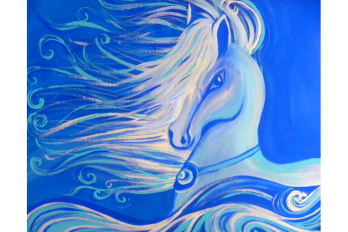
Through cursed forests, forgotten fortresses, and dreams wrapped in mist, Hope carries Kalyna—as a companion, and also as a reminder. Hope’s presence whispers of a bond unfinished. Of a soul still riding. Of a story not yet done.
And in this story… Some souls have not finished riding.
Soulmate and Sacrifice Campaign
The portal is open—
Our Kickstarter campaign for Soulmate and Sacrifice is now LIVE, and we’re inviting you to step into a world where ancient myth meets modern danger.
Dive into a world where:
Samodivi wield moonlight as weaponsZmey dragons sip wine and harbor secretsA ring remembers your soul’s true matchAnd a ghost mare waits by the sea for a rider who may never returnSoulmate and Sacrifice is live on Kickstarter. If you believe myths are still alive—this one is for you. Click here to join us on Kickstarter to help bring Kalyna’s journey—and the ancient lore that inspired it—to life. Because in this world, and the next, some rides never truly end.
With every beat of the drum and every gallop of her mare, Kalyna rides closer to her fate. Thank you for riding with us!
More Books to Check Out
Also check out these other fantastic stories now on Kickstarter.
Hungry Fur Love: The Witches of Castor’s Corner Book Series
Exclusive Paranormal Romantic Comedy Relaunch, featuring Witches and their Shifter fated mates, Collector’s Edition by C.D. Gorri
The Fabric of the Realm: A Fantasy Romance Special Edition
A slow burn, fantasy romance retelling of the Rumpelstiltskin fairytale… with a major twist. Book One of The Corrupted Realm.
https://www.kickstarter.com/projects/sbryazakhov/the-fabric-of-the-realm-special-edition
The Secret Stalker: Limited Edition Book 1
Betrayal, secrets, and dark obsession hide around every corner in this thrilling Psychological Thriller series.
https://www.kickstarter.com/projects/jaydecollins/the-secret-stalker-limited-edition-trilogy-book-1
Warriors & Mages: Limited Edition Romantasy Trilogy
Strangers take a risk, entwining their fates on an unexpected adventure in this Jane Austen meets Skyrim fantasy romance.
https://www.kickstarter.com/projects/vkdixon/warriors-and-mages-limited-edition-romantasy-trilogy
And be sure to check out even more campaigns running throughout July!
https://books.bookfunnel.com/fantastykickstarterjuly2025/utyhfy1tu7
June 20, 2025
Summer Solstice Magic
It’s June. My favorite month.
In the northern hemisphere. it’s time to celebrate the Summer Solstice. The air is filled with enchantment.
The days are long, warm, and perfumed with the scent of lavender. Jasmine and roses in my garden are overflowing with blossoms, and fireflies light up the night.
In Bulgaria and other Slavic countries, June 24, called Eniovden, is a sacred day that marks the celebration of St. John and the arrival of summer.
According to folk tradition, herbs gathered on this day are at the height of their power: healing, enchanting, and even dangerous. On Eniovden, 77½ magical herbs are woven into a giant wreath. Girls pass through it as a rite of passage into adulthood—and to protect themselves from samodivi (woodland fairies) and repel zmeys (dragons). The latter are known to abduct young girls as brides, so the wreath becomes their shield.
Samodivi: Guardians of Nature
As you know if you’ve read anything I’ve written, I’m fascinated by samodivi. They protect nature and possess ancient knowledge of herbs. If one of the fairies favors you, you’ll become her soul-sister and a powerful healer.
In In my urban fantasy fiction series, The Cursed Ring, Kalyna is a samodiva, and her soul sister is an old woman named Sultana. But Kalyna is so much more. She protects nature from the evil fairies called Yudi. Kalyna has a magical bracelet that becomes a snake whip to help her defeat the evil Yudi.
Zmey: A Different Kind of Dragon
The Bulgarian zmey is unlike other dragons of this name found throughout Eastern Europe.
One of the most haunting legends from my childhood was about a zmey with glowing eyes and a burning desire for human brides. Stories tell how he lives high in the mountains or deep within forests. He’s always watching, waiting, and when he chooses a girl, no one can stop him.
In The Cursed Ring series, the zmey lives on as a man called Goran. The mysterious, seductive, and rich vintner has piercing eyes and small hidden wings. His vineyard produces blood-red wine that holds ancient spells. He loves the finer things—fast cars, beautiful women.
Don’t let his charm deceive you.
He’s dangerously powerful and demands a steep price for those how seek his favors. And… he’s on first-name basis with the legendary Dracula.
Yellow Bedstraw
Let’s return to the wreath. While each herb has a special role, the crown jewel is yellow bedstraw, which gives its name to the holiday (Enyovche).
Girls keep bouquets of it all year for healing and protection because they believe the herb protects against Samodivi, zmeys, and diseases (which were personified).
Another Eniovden ritual involves decorating a young girl with the herb and parading her around the village as Enio’s bride, commemorating a tragic love story between a girl named Stana and a boy named Enio.
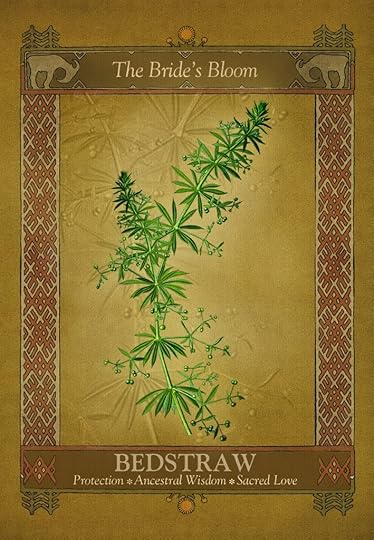
Fortune-telling is also common on Eniovden. Girls tie rings to flowering herbs and place them in water. The village’s eldest woman draws each ring and reveals the girl’s fate—wealth, marriage, or other blessings.
Yellow bedstraw also protects pregnant women from Navi, demonic creatures with birdlike bodies and distorted baby faces. At seven to eight months pregnant, women step through a wreath of yellow bedstraw three times for protection.
The herb is worn in belts to prevent back pain during harvest and added to children’s baths to ward off illness like polio.
Raskovnik – The Unlocker
One of my favorite magical herbs found in the wreath is the Raskovnik (Water Clover, Marsilea quadrifolia).
It’s one of the most secret magical herbs. People believe that the herb has strong alchemic ability and can transform iron into gold. More common, however, is the belief the herb can brings the person who finds it love, happiness, luck, and wealth. I wish the list included eternal youth as well… Some say the raskovnik makes whatever its owner desires come true.
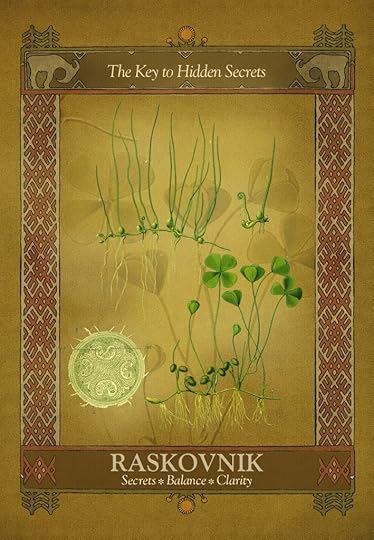
According to legend, the herb can unlock any padlock or closed gate. It has the power to make buried treasures rise from the ground: it does this by splitting the ground at the place where a treasure is hidden, so that people can locate it. But if the herb breaks, it’ll lose its magical powers.
In some regions of Balkans, the treasure itself was a giant man in chains. He’d would request that a raskovnik be brought to him. The raskovnik would break the chains and the man would disappear into the ground, replaced by a cauldron filled with gold coins.
It’s said only a turtle or a hedgehog can find it.
Chamomile & Salt Pouch
In these stressful times, let’s return to Mother Nature’s wisdom, which still speaks in every flower and leaf. The following is a simple healing ritual for peace and cleansing you can try.
Place chamomile and coarse salt into a linen pouch. Carry it with you or place it under your pillow at night. Tradition says it drives away restlessness and brings soft, peaceful dreams.
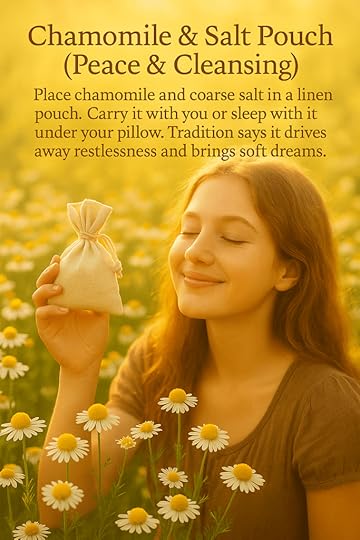
Oracle of the Slavic Soul
We previously published a book about magical herbs (77½ Magical Healing Herbs), and now we’ve taken the herbs in that book and created oracle cards, “The Oracle of the Slavic Soul.” It’s more than a deck—it’s a sacred experience. Rooted in ancient traditions and blooming with herbal magic, each of the 78 cards helps you heal, explore, and grow.
And beyond the cards?
You’ll unlock rituals, stories, and soul-deep practices to reconnect with your intuition and the natural world. If our project is successful, we plan to publish an art book celebrating these magical herbs in full color.
Support our campaign and step into the wildwood of spirit, where every leaf whispers wisdom.
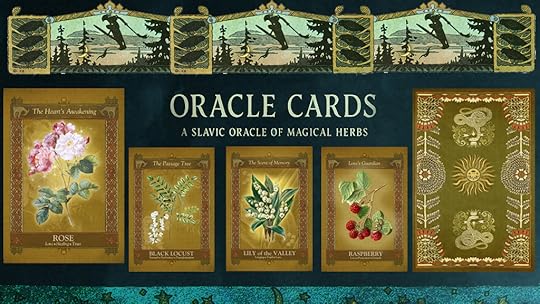
Soulmate & Sacrifice Urban Fantasy
We’d also love to have your support for our Urban Fantasy campaign, launching July 8, 2025. You’ll meet Kalyna and his sister Morena. Stefan, the soulmate who doesn’t remember his past. Goran the seductive dragon. And so much more.
He’s her fated mate. She’s his curse. A dark fae romance steeped in Slavic myth and Thracian blood rites.
Wishing you a magical, healing, and joyful summer.

I’m thrilled to be part of Author Nation’s new Kickstart Together cohort in partnership with Kickstarter! This program unites indie authors to support each other, share resources, and elevate our campaigns.
Back three or more cohort campaigns and get a VIP Swag Bag ($100+ value) at Reader Nation on November 7, 2025, at the Paris Hotel in Las Vegas!
See all the details at https://www.readernation.live/kickstart-together 🎉

Top Secret Shop of Horrors: A New Post-Apocalyptic Joe Book by Joe Gillis
A Humorous Science Fiction Book Blended with Horror Comedy, Movies, Monsters, Clones, and Sci-Fi Fun
[image error]
The Artisan Author: Your Way Out of the Self-Pub Rat Race by Johnny B. Truant
You dreamed of being an author … until Rapid Release turned it into a low-profit, high-stress grind. Here’s your ticket to freedom.
[image error]
Kings of the Fire: Special Edition Omnibus – Spicy Shifters! by Lily Cahill
Four dragon shifters must find their fated mates to reclaim the throne of the magical world. NSFW art and more!
[image error]
May 16, 2025
Sun-Kissed Spirits
Discover the ancient wisdom of spring rituals, blooming herbs, and the radiant power of the sun in Slavic folklore — and how they inspired our magical Oracle deck.
I remember the warmth of May mornings in my childhood — the smell of white lilac, the fresh green trees and grass dotted with a blanket of yellow dandelions and wild purple violets. Swallows gathered mud and straw to build nests under the eaves. Hens prepared to brood. And my grandmother’s hands were stained green from foraging dock and nettles. She’d return from the fields with a basket filled with wild herbs and a smile as bright as the sun. That’s when we knew: spring had truly arrived.
In Slavic tradition, May is more than a season: it’s a threshold. The earth stirs fully awake, the veil between the human and spirit worlds grows thin, and life bursts into full bloom. Samodivi return to the human world and they’re getting ready for Rusalki week in June.
Festivals like Gergyovden (St. George’s Day) and St. Konstantinos and Elena fill this month with rituals. Villagers gather at special places called an obrok to pay homage to St. George the dragon slayer.
In Bulgarian folklore, the dragon is called Zmey, and he’s a shapeshifter. If you want to meet him, you can read our book about dragons or follow our Kickstarter campaign The Cursed Ring to meet him and enjoy the dragon journey.
Later in the month, on May 21, Bulgarians celebrate St. Konstantin and Elena. On this day, festive liturgies are held in churches, and in some regions of the country, especially in Strandzha, a unique ritual called “nestinarstvo” takes place — a barefoot dance on burning embers, combining Christian and ancient pagan elements. This ritual is recognized by UNESCO as intangible cultural heritage of humanity. If you want to see the ritual you also can go to the Black Sea coast and watch it in person at the local restaurants like an attraction.
It was a time of sun worship, nature magic, and protection spells — a celebration of life’s return. In The Cursed Ring series, our character Kalyna is a great dancer. She controls the elements. It’s fun when you use fiction to teach the world about different cultures.
In Slavic lore, the sun isn’t just a ball of light. He’s a man called Raiko in many songs. He also has a wife — the most beautiful girl from the village. She’s the Sun Bride. The most radiant girl, chosen by the sun. With her return, herbs grow potent, dreams become prophetic, and healing becomes possible.

The sun’s golden path was believed to awaken the soul and ignite intuition. Herbalists would only pick plants touched by morning light. My grandmother told me that plants gathered in May, under the gaze of the Sun Bride, held the strongest magic: for healing, for love, for protection.
Our Oracle deck brings these sunlit traditions to life, card by card. Each herb holds a secret, and each story blossoms from Slavic soil.
The following are a few herbs in the deck, with some rituals and affirmations you’ll discover. They’re used in many rituals, magical or otherwise. Each of these herbs was chosen for its magical and cultural significance — gathered (symbolically) under May’s sun and infused with ancestral power.
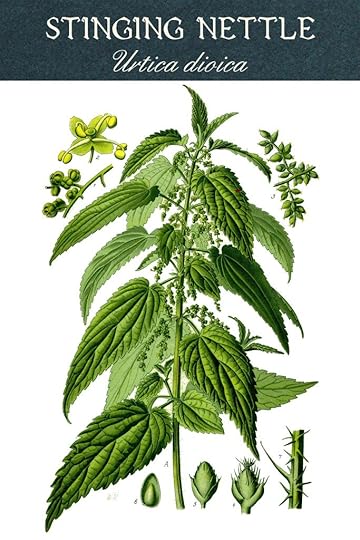
My grandmother’s creamy nettle soup — sprinkled with feta and served with warm bread — wasn’t just delicious, it was medicine. The herb is rich in iron and great for the body, giving essential nutrients. Nettle protected from evil spirits and was worn in bundles to ward off illness. It was an herb of resilience and renewal.
Breaking Spells: Carry nettle in a pouch, or slip it into your shoes to guard against hexes, curses, and psychic attacks. When doing so, say: “Where I walk, no harm may tread. I’m wrapped in the strength of green-threaded dread.”
This is a quiet charm of reversal and magical defense.
Affirmation: “No ill will can touch me. I walk in strength, shielded by my own power.”

Known as the “Dream Herb,” wormwood or mugwort was burned to guide souls and ward off the unseen. It lined doorways during Rusalka Week and was braided into midsummer wreaths for protection. In Bulgaria and I think in Eastern Europe, it’s used to make a wine called Pelin, which is popular from May 1 until the summer.
This drink is made by mixing red or white wine with Artemisia absinthium (Bulgarian: Пелин) during fermentation, giving the wine a bitter, refreshing taste. Pelin wine differs from absinthe and pelinkovac, which are based on distilled alcohol rather than wine.
Dream Clarity: Place wormwood under your pillow or burn it as incense before sleep. Ask for clarity and guidance through your dreams by saying: “By dusk and dream, by spirit’s hand, let wisdom rise where visions land.” Keep a journal close to capture what comes.
This ritual enhances intuitive dreaming and invites messages from beyond the veil.
Affirmation: “I trust the wisdom of my dreams. My mind is clear, and I receive the guidance I need.”

Plucked near the summer solstice, in some regions around May. This golden herb was believed to chase away sorrow and shadow spirits, and it’s used for guidance and healing. Hung above doors or steeped in oil, it brought light to the home and clarity to the mind.
Sunrise Healing: At dawn, pick a sprig of St. John’s wort and place it in a bowl of warm water. Hold the bowl to the rising sun, letting the sunlight shine on it as you focus on your intentions for healing. Speak the following affirmation as the sun’s light strengthens the herb’s energy: “As the sun rises, so does my might. I embrace healing. I embrace the light.”
This ritual harnesses the power of the sun to initiate healing for both physical and emotional wounds.
Affirmation : “With the rising sun, I’m renewed. My healing journey begins now.”
Why We Created the Slavic OracleThe Slavic Oracle of Magical Herbs is more than a divination tool. It’s a revival. Each of the 78 cards channels old-world herbal wisdom, with illustrations steeped in folk symbolism and messages rooted in Slavic lore. We created it to honor our roots, to keep our grandmother’s stories alive, and to offer a magical mirror for modern seekers. Whether you’re new to this tradition or grew up with tales of the Samodiva and forest spirits, this deck is an invitation — to remember, to reflect, and to reconnect.
Let the Sun Guide YouThis May, we invite you to listen. To the sound of nature, the leaves, the breeze, the birds. To the whisper of our grandmothers’ voices. Think about how they used the herbs in their kitchens: to cook, to heal, and to create rituals. To the hum of ancient traditions blooming back to life.
Let the sun guide your spirit, and let the herbs whisper their secrets.
Join us in bringing Slavic soul magic back to life and follow our project: Oracle of the Slavic Soul.
FREE BOOK: Court of Light and DarkDo you love urban fantasy? Heather Hyatt is looking to distribute ARCs of her upcoming book. If you’d like to receive this FREE advance review copy, fill out her Google form to make your request:
https://forms.gle/YFiEh2jjYD2pk1v7A
April 18, 2025
Easter: A Time for Tradition, Sweet Bread, and New Beginnings
This April, something special is happening – both Orthodox and Catholic Easter fall on the same day. Usually, my family celebrates them both, so this year, it’s only one celebration.
This is a rare event, one that invites reflection, celebration, and the merging of shared traditions. It’s a time to cook, eat, and be good to each other. Easter is a reminder of the deep cultural connections we all share, regardless of our different practices.
I was born and raised in Bulgaria, where Easter is not just about religion; it’s about vibrant customs that have been passed down for generations.
One such tradition is Lazaruvane, a colorful and joyous ritual that takes place the Saturday before Easter. Young girls, dressed in beautiful flowers, go door to door, singing songs that herald the coming of spring and the resurrection of Christ. It is ritual signifying girls have become women. It’s a ritual full of life, and every song carries the hope of a prosperous year ahead.
The spirit of renewal is palpable, much like the blooming of nature itself – even if, as we saw this year, snowflakes make an unexpected appearance in April! If you’re interested in learning more about Lazaruvane and other meaningful rituals, I dive deeper into these traditions in my book Love Light Rituals, available on all major retailers.
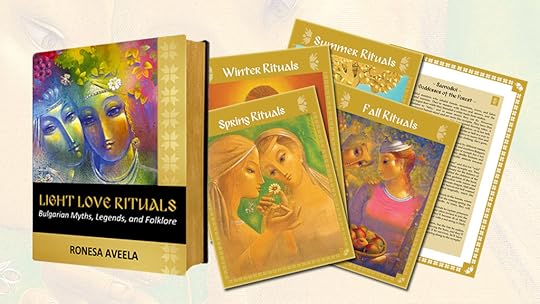
And then there’s Kozunak, the sweet braided bread that’s a staple on any Bulgarian Easter table. I’ve been busy in the kitchen this week, preparing a new variation of this beloved bread. I call it Dubai Bread, a creative twist on the traditional recipe, featuring the luxurious taste of pistachio butter. It’s my little tribute to the warmth and beauty of the Middle East, combining the comforting flavors of home with the exotic allure of Dubai.
At the moment if you visit TikTock or any other social media platform and look up Dubai chocolate you will see that’s a sensation. They even opened a store for this chocolate in the most famous street in Boston. The scent of this bread fills the house and brings a new sense of joy to our Easter preparations.
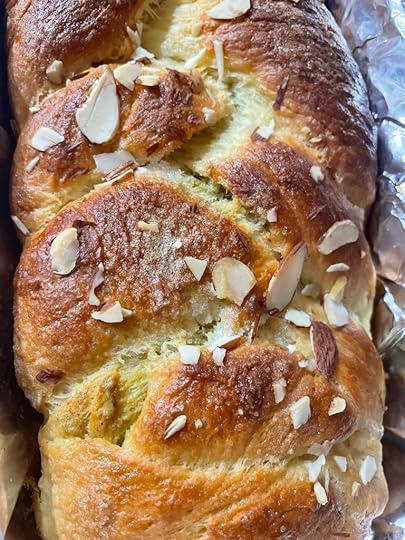
You can find the recipe for this delicious bread below, so you can try making it yourself.
If you don’t have pistachio paste, no worries! You can substitute it with a mix of cacao powder and sugar, which will give you a similar, delightful result. And if you’re short on time or just want a fun twist, you can bake this bread as muffins – they make a perfect breakfast or a lovely treat to enjoy with your tea or coffee.
Aside from my Easter preparations, I’m also busy working on the second book in The Cursed Ring series, which we will publish first in a special edition through our Kickstarter campaign. We are excited that we can now reveal the cover for book 2.

Writing is such an exciting journey, but I always make time to relax and reconnect with nature in my garden here in Virginia. Creating a camellia garden in addition to my rose garden has been one of my greatest joys – these beautiful flowers bloom all year round, bringing vibrant life to the garden, even through the grayest winter days.
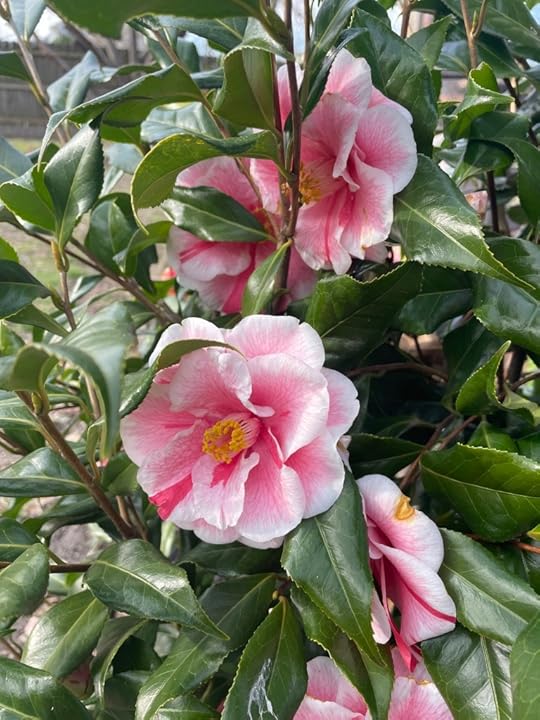
Flowers from my garden
The birds love it, and I enjoy the rich red flowers that stand out so brightly. One of the camellias has even become a hiding spot for my cat, Scarlet, whom we adopted during Covid. She’s now an integral part of our family and my fellow gardener. It’s her favorite quiet retreat, and it always makes me smile when I see her there, taking a break from her busy adventures. This month I also have a visitor, my daughter’s puppy, a joyful golden doodle, He’s full of energy and love and is my shadow.

Flowers from my garden
As everything blooms around us, there’s a saying from my grandmother that lingers in my mind: “If there’s an ‘R’ in the month name, it’s a cold one.” April may have surprised us with a bit of snow, but her wisdom reminds me that May is just around the corner, and with it, the promise of warmth, flowers, and brighter days ahead.
Easter, in its many forms, is a time to gather with loved ones, honor our traditions, and celebrate the simple joys of life. This year, I’m grateful for the opportunity to share these moments with you all and to reflect on the beauty of both old and new customs.
Wishing everyone a blessed Easter filled with joy, love, and, of course, plenty of sweet bread.

I’m sharing the recipe for Easter bread with pistachio. I made a cream today: pistachio plus almond butter and powdered sugar. It makes a really nice cream for chocolate or even for biscuits. If you don’t have almond butter, you can use avocado oil. Easter bread with pistachio cream. If you don’t have pistachio cream, you can also use a mixture of cocoa powder and sugar with a few drops of water to create a paste and use it as the filling for the bread.
Ingredients:
4 medium eggs200 ml cold milkzest of one orange and one lemon (few drops of vanilla)100 g sugar2 Tbsp honey (feeds the yeast)1/2 tsp salt21 g dry yeast (one package)550 g white flour (your choice)70 g cold butter (I softened in the microwave for 10 seconds)Filling:
200 g pistachio cream (or a paste made from cocoa powder, sugar, and a few drops of water)For brushing the bread and sprinkling:
1 egg + 1 Tbsp milk1 Tbsp sugar for sprinkling30 g pistachios (I used almonds)Method:
In the bowl of a mixer, beat the eggs. Add the cold milk, sugar, honey, and citrus zest. Beat for a few minutes.Add the flour mixed with salt and yeast. Change the whisk to the dough hook.Start mixing on the highest speed for 5-6 minutes. Then, gradually add the cold butter (which has been softened in the microwave for 10 seconds), and once the dough absorbs it, continue mixing until the dough forms around the hook of the mixer.Remove the dough onto an oiled countertop and gently shape it into a smooth ball. Add more flour if needed.Divide the dough into 3 parts and braid it. Once the dough has risen, you don’t need to knead it again, just shape it into the bread.Transfer the braided dough into a deep greased bowl. Place it in an oven preheated to 50°C (122°F) to rise. Once the bowl is in the oven, turn it off. When the dough has risen by two fingers, it’s ready.Place the braided dough in baking trays and let it rise again in the same way.Brush with the egg and milk mixture, and sprinkle with nuts and sugar.Bake in a preheated oven at 160°C (320°F) until done (I baked it for 30 minutes). Use wooden skewers to check for moisture. Place an oven-safe dish with water in the oven while baking to make the bread softer. After 10 minutes of baking, cover with foil and remove it 2-3 minutes before taking the bread out.

